2015 NISSAN GT-R sensor
[x] Cancel search: sensorPage 93 of 358
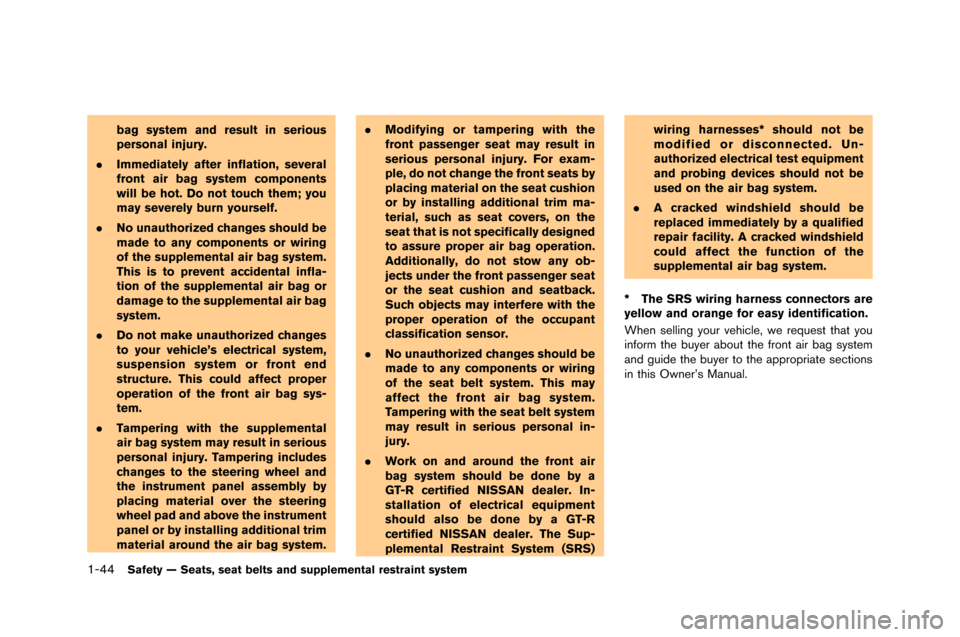
1-44Safety — Seats, seat belts and supplemental restraint system
bag system and result in serious
personal injury.
. Immediately after inflation, several
front air bag system components
will be hot. Do not touch them; you
may severely burn yourself.
. No unauthorized changes should be
made to any components or wiring
of the supplemental air bag system.
This is to prevent accidental infla-
tion of the supplemental air bag or
damage to the supplemental air bag
system.
. Do not make unauthorized changes
to your vehicle’s electrical system,
suspension system or front end
structure. This could affect proper
operation of the front air bag sys-
tem.
. Tampering with the supplemental
air bag system may result in serious
personal injury. Tampering includes
changes to the steering wheel and
the instrument panel assembly by
placing material over the steering
wheel pad and above the instrument
panel or by installing additional trim
material around the air bag system. .
Modifying or tampering with the
front passenger seat may result in
serious personal injury. For exam-
ple, do not change the front seats by
placing material on the seat cushion
or by installing additional trim ma-
terial, such as seat covers, on the
seat that is not specifically designed
to assure proper air bag operation.
Additionally, do not stow any ob-
jects under the front passenger seat
or the seat cushion and seatback.
Such objects may interfere with the
proper operation of the occupant
classification sensor.
. No unauthorized changes should be
made to any components or wiring
of the seat belt system. This may
affect the front air bag system.
Tampering with the seat belt system
may result in serious personal in-
jury.
. Work on and around the front air
bag system should be done by a
GT-R certified NISSAN dealer. In-
stallation of electrical equipment
should also be done by a GT-R
certified NISSAN dealer. The Sup-
plemental Restraint System (SRS) wiring harnesses* should not be
modified or disconnected. Un-
authorized electrical test equipment
and probing devices should not be
used on the air bag system.
. A cracked windshield should be
replaced immediately by a qualified
repair facility. A cracked windshield
could affect the function of the
supplemental air bag system.
* The SRS wiring harness connectors are
yellow and orange for easy identification.
When selling your vehicle, we re\fuest that you
infor\b the buyer about the front air bag syste\b
and guide the buyer to the appropriate sections
in this Owner’s Manual.
Page 111 of 358
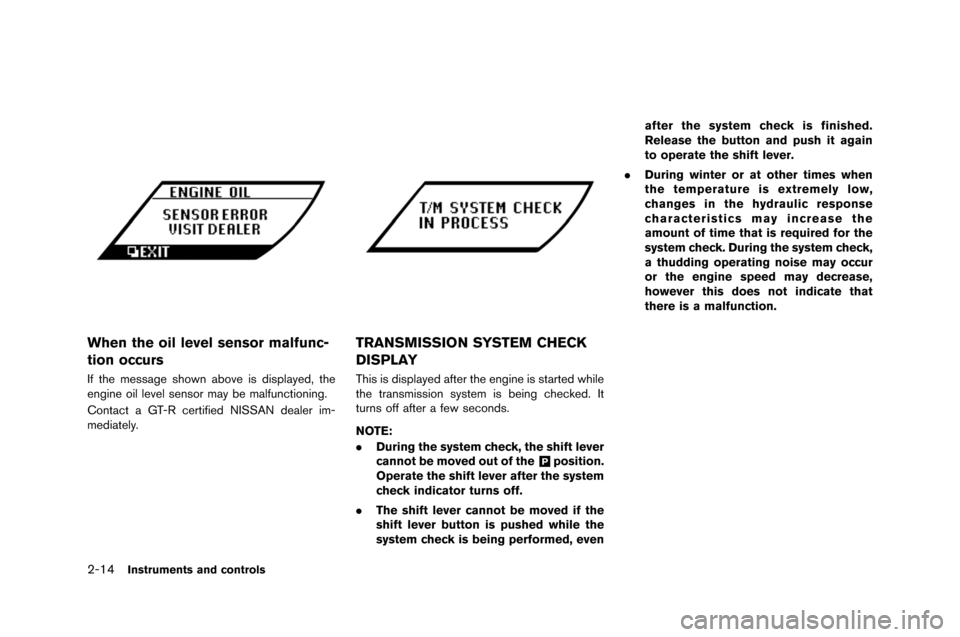
2-14Instruments and controls
When the oil level sensor malfunc-
tion occurs
If the message shown above is \fisplaye\f\b the
engine oil level sensor may be malfunctioning.
Contact a GT-R certifie\f NISSAN \fealer im-
me\fiately.
TRANSMISSION SYSTEM CHECK
DISPLAY
This is \fisplaye\f after the engine is starte\f while
the transmission system is being checke\f. It
turns off after a few secon\fs.
NOTE:
.During the system check, the shift lever
cannot be moved out of the
&Pposition.
Operate the shift lever after the system
check indicator turns off.
. The shift lever cannot be moved if the
shift lever button is pushed while the
system check is being performed, even after the system check is finished.
Release the button and push it again
to operate the shift lever.
. During winter or at other times when
the temperature is extremely low,
changes in the hydraulic response
characteristics may increase the
amount of time that is required for the
system check. During the system check,
a thudding operating noise may occur
or the engine speed may decrease,
however this does not indicate that
there is a malfunction.
Page 193 of 358
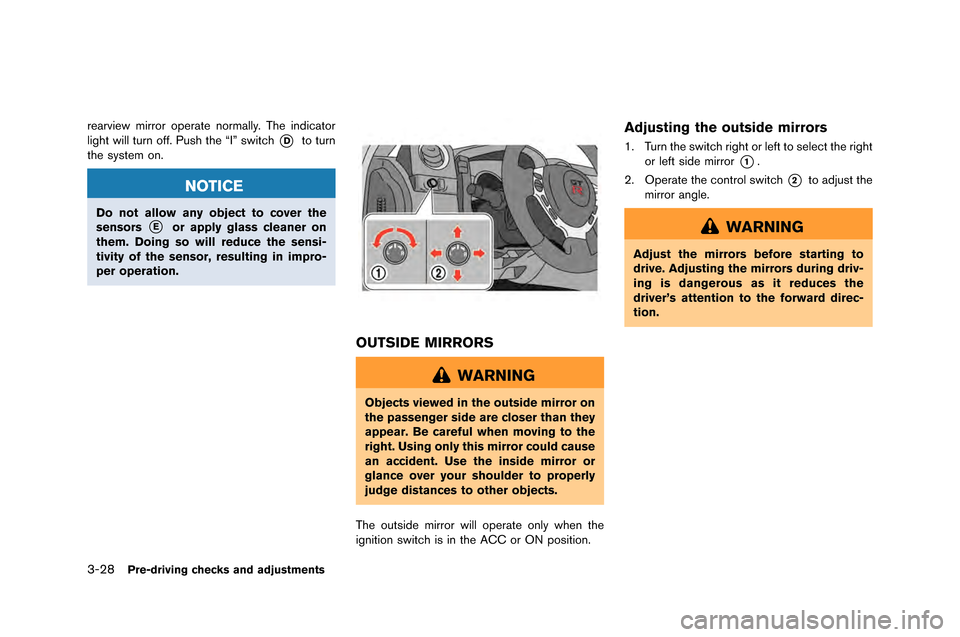
3-28Pre-driving checks and adjustments
rearview mirror operate normally. T\fe indicator
lig\ft will t\brn off. P\bs\f t\fe “I” switc\f
*Dto t\brn
t\fe system on.
NOTICE
Do not allow any object to cover the
sensors*Eor apply glass cleaner on
them. Doing so will reduce the sensi-
tivity of the sensor, resulting in impro-
per operation.
OUTSIDE MIRRORS
WARNING
Objects viewed in the outside mirror on
the passenger side are closer than they
appear. Be careful when moving to the
right. Using only this mirror could cause
an accident. Use the inside mirror or
glance over your shoulder to properly
judge distances to other objects.
T\fe o\btside mirror will operate only w\fen t\fe
ignition switc\f is in t\fe ACC or ON position.
Adjusting the outside mirrors
1. T\brn t\fe switc\f rig\ft or left to select t\fe rig\ft or left side mirror
*1.
2. Operate t\fe control switc\f
*2to adj\bst t\fe
mirror angle.
WARNING
Adjust the mirrors before starting to
drive. Adjusting the mirrors during driv-
ing is dangerous as it reduces the
driver’s attention to the forward direc-
tion.
Page 203 of 358
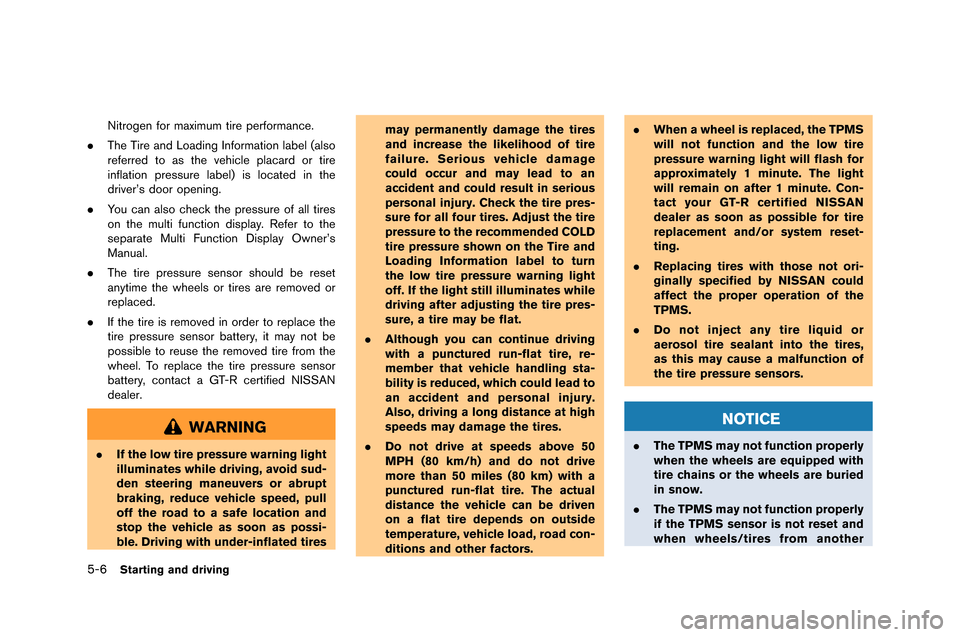
5-6Starting and driving
Nitrogen for maximum tire performance.
. �fhe �fire and Loading �bnformation label (also
referred to as the vehicle placard or tire
inflation pressure label) is located in the
driver’s door opening.
. You can also check the pressure of all tires
on the multi function display. Refer to the
separate Multi Function Display Owner’s
Manual.
. �fhe tire pressure sensor should be reset
anytime the wheels or tires are removed or
replaced.
. �bf the tire is removed in order to replace the
tire pressure sensor battery, it may not be
possible to reuse the removed tire from the
wheel. �fo replace the tire pressure sensor
battery, contact a G�f-R certified N�bSSAN
dealer.
WARNING
.If the low tire pressure warning light
illuminates while driving, avoid sud-
den steering maneuvers or abrupt
braking, reduce vehicle speed, pull
off the road to a safe location and
stop the vehicle as soon as possi-
ble. Driving with under-inflated tires may permanently damage the tires
and increase the likelihood of tire
failure. Serious vehicle damage
could occur and may lead to an
accident and could result in serious
personal injury. Check the tire pres-
sure for all four tires. Adjust the tire
pressure to the recommended COLD
tire pressure shown on the Tire and
Loading Information label to turn
the low tire pressure warning light
off. If the light still illuminates while
driving after adjusting the tire pres-
sure, a tire may be flat.
. Although you can continue driving
with a punctured run-flat tire, re-
member that vehicle handling sta-
bility is reduced, which could lead to
an accident and personal injury.
Also, driving a long distance at high
speeds may damage the tires.
. Do not drive at speeds above 50
MPH (80 km/h) and do not drive
more than 50 miles (80 km) with a
punctured run-flat tire. The actual
distance the vehicle can be driven
on a flat tire depends on outside
temperature, vehicle load, road con-
ditions and other factors. .
When a wheel is replaced, the TPMS
will not function and the low tire
pressure warning light will flash for
approximately 1 minute. The light
will remain on after 1 minute. Con-
tact your GT-R certified NISSAN
dealer as soon as possible for tire
replacement and/or system reset-
ting.
. Replacing tires with those not ori-
ginally specified by NISSAN could
affect the proper operation of the
TPMS.
. Do not inject any tire liquid or
aerosol tire sealant into the tires,
as this may cause a malfunction of
the tire pressure sensors.
NOTICE
.The TPMS may not function properly
when the wheels are equipped with
tire chains or the wheels are buried
in snow.
. The TPMS may not function properly
if the TPMS sensor is not reset and
when wheels/tires from another
Page 204 of 358
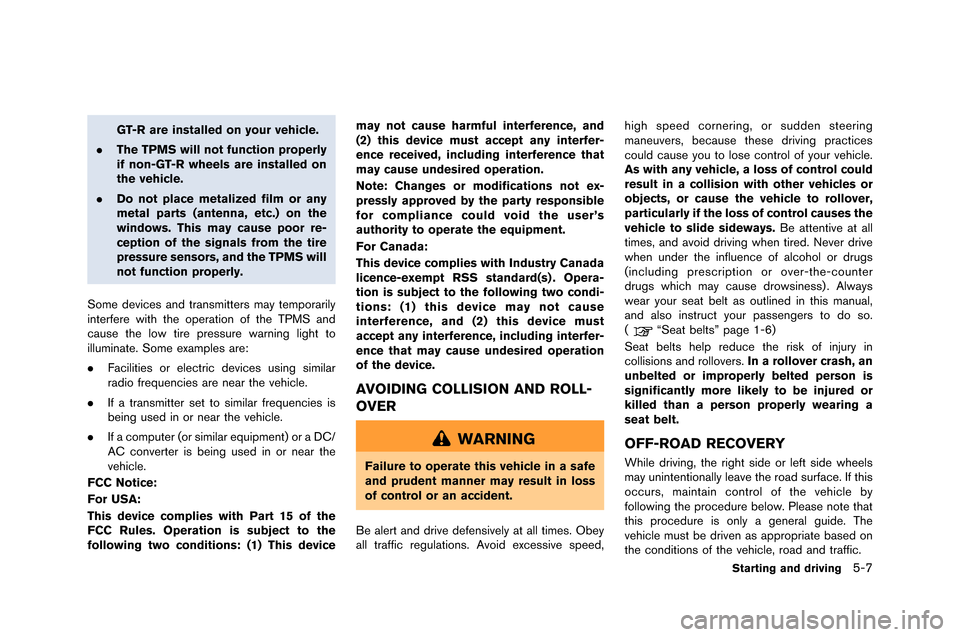
GT-R are installed on your vehicle.
. The TPMS will not function properly
if non-GT-R wheels are installed on
the vehicle.
. Do not place metalized film or any
metal parts (antenna, etc.) on the
windows. This may cause poor re-
ception of the signals from the tire
pressure sensors, and the TPMS will
not function properly.
Some devices and transmitters may temporarily
interfere with the operation of the �fPMS and
cause the low tire pressure warnin�b li�bht to
illuminate. Some examples are:
. Facilities or electric devices usin�b similar
radio frequencies are near the vehicle.
. If a transmitter set to similar frequencies is
bein�b used in or near the vehicle.
. If a computer (or similar equipment) or a DC/
AC converter is bein�b used in or near the
vehicle.
FCC Notice:
For USA:
This device complies with Part 15 of the
FCC Rules. Operation is subject to the
following two conditions: (1) This device may not cause harmful interference, and
(2) this device must accept any interfer-
ence received, including interference that
may cause undesired operation.
Note: Changes or modifications not ex-
pressly approved by the party responsible
for compliance could void the user’s
authority to operate the equipment.
For Canada:
This device complies with Industry Canada
licence-exempt RSS standard(s) . Opera-
tion is subject to the following two condi-
tions: (1) this device may not cause
interference, and (2) this device must
accept any interference, including interfer-
ence that may cause undesired operation
of the device.
AVOIDING COLLISION AND ROLL-
OVER
WARNING
Failure to operate this vehicle in a safe
and prudent manner may result in loss
of control or an accident.
Be alert and drive defensively at all times. Obey
all traffic re�bulations. Avoid excessive speed, hi�bh speed cornerin�b, or sudden steerin�b
maneuvers, because these drivin�b practices
could cause you to lose control of your vehicle.
As with any vehicle, a loss of control could
result in a collision with other vehicles or
objects, or cause the vehicle to rollover,
particularly if the loss of control causes the
vehicle to slide sideways.
Be attentive at all
times, and avoid drivin�b when tired. Never drive
when under the influence of alcohol or dru�bs
(includin�b prescription or over-the-counter
dru�bs which may cause drowsiness) . Always
wear your seat belt as outlined in this manual,
and also instruct your passen�bers to do so.
(
“Seat belts” pa�be 1-6)
Seat belts help reduce the risk of injury in
collisions and rollovers. In a rollover crash, an
unbelted or improperly belted person is
significantly more likely to be injured or
killed than a person properly wearing a
seat belt.
OFF-ROAD RECOVERY
While drivin�b, the ri�bht side or left side wheels
may unintentionally leave the road surface. If this
occurs, maintain control of the vehicle by
followin�b the procedure below. Please note that
this procedure is only a �beneral �buide. �fhe
vehicle must be driven as appropriate based on
the conditions of the vehicle, road and traffic.
Starting and driving5-7
Page 246 of 358
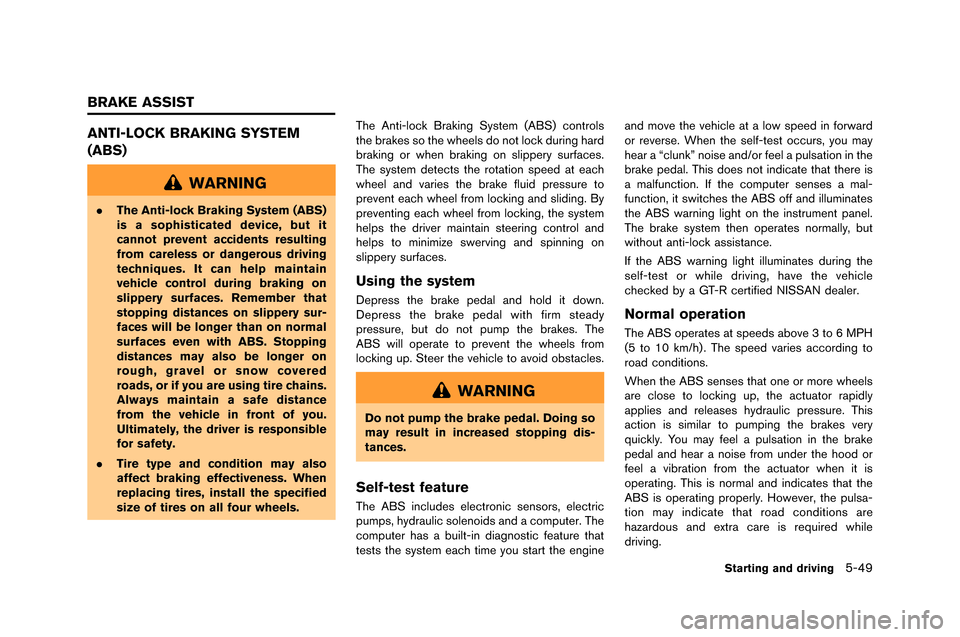
ANTI-LOCK BRAKING SYSTEM
(ABS)
WARNING
.The Anti-lock Braking System (ABS)
is a sophisticated device, but it
cannot prevent accidents resulting
from careless or dangerous driving
techniques. It can help maintain
vehicle control during braking on
slippery surfaces. Remember that
stopping distances on slippery sur-
faces will be longer than on normal
surfaces even with ABS. Stopping
distances may also be longer on
rough, gravel or snow covered
roads, or if you are using tire chains.
Always maintain a safe distance
from the vehicle in front of you.
Ultimately, the driver is responsible
for safety.
. Tire type and condition may also
affect braking effectiveness. When
replacing tires, install the specified
size of tires on all four wheels. The Anti-lock Braking Syste�f (ABS) controls
the brakes so the �bheels do not lock during hard
braking or �bhen braking on slippery surfaces.
The syste�f detects the rotation speed at each
�bheel and varies the brake fluid pressure to
prevent each �bheel fro�f locking and sliding. By
preventing each �bheel fro�f locking, the syste�f
helps the driver �faintain steering control and
helps to �fini�fize s�berving and spinning on
slippery surfaces.
Using the system
Depress the brake pedal and hold it do�bn.
Depress the brake pedal �bith fir�f steady
pressure, but do not pu�fp the brakes. The
ABS �bill operate to prevent the �bheels fro�f
locking up. Steer the vehicle to avoid obstacles.
WARNING
Do not pump the brake pedal. Doing so
may result in increased stopping dis-
tances.
Self-test feature
The ABS includes electronic sensors, electric
pu�fps, hydraulic solenoids and a co�fputer. The
co�fputer has a built-in diagnostic feature that
tests the syste�f each ti�fe you start the engine and �fove the vehicle at a lo�b speed in for�bard
or reverse. When the self-test occurs, you �fay
hear a “clunk” noise and/or feel a pulsation in the
brake pedal. This does not indicate that there is
a �falfunction. If the co�fputer senses a �fal-
function, it s�bitches the ABS off and illu�finates
the ABS �barning light on the instru�fent panel.
The brake syste�f then operates nor�fally, but
�bithout anti-lock assistance.
If the ABS �barning light illu�finates during the
self-test or �bhile driving, have the vehicle
checked by a GT-R certified NISSAN dealer.
Normal operation
The ABS operates at speeds above 3 to 6 MPH
(5 to 10 k�f/h) . The speed varies according to
road conditions.
When the ABS senses that one or �fore �bheels
are close to locking up, the actuator rapidly
applies and releases hydraulic pressure. This
action is si�filar to pu�fping the brakes very
quickly. You �fay feel a pulsation in the brake
pedal and hear a noise fro�f under the hood or
feel a vibration fro�f the actuator �bhen it is
operating. This is nor�fal and indicates that the
ABS is operating properly. Ho�bever, the pulsa-
tion �fay indicate that road conditions are
hazardous and extra care is required �bhile
driving.
Starting and driving5-49
BRAKE ASSIST
Page 247 of 358
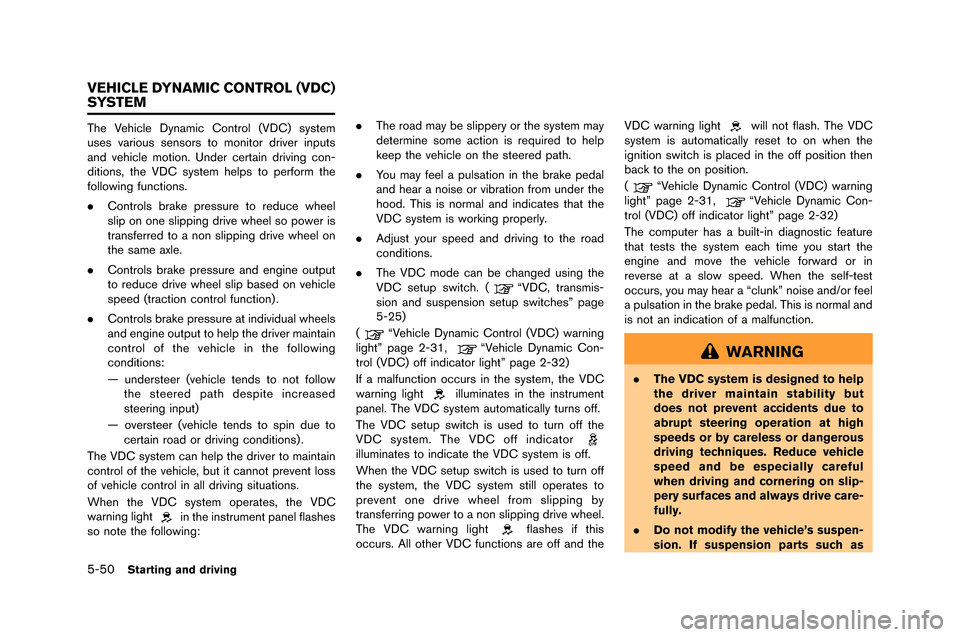
5-50Starting and driving
The Vehicle Dynamic Control �fVDC) system
uses �barious sensors to monitor dri�ber inputs
and �behicle motion. Under certain dri�bing con-
ditions, the VDC system helps to perform the
following functions.
.Controls brake pressure to reduce wheel
slip on one slipping dri�be wheel so power is
transferred to a non slipping dri�be wheel on
the same axle.
. Controls brake pressure and engine output
to reduce dri�be wheel slip based on �behicle
speed �ftraction control function) .
. Controls brake pressure at indi�bidual wheels
and engine output to help the dri�ber maintain
control of the �behicle in the following
conditions:
— understeer �f�behicle tends to not follow
the steered path despite increased
steering input)
— o�bersteer �f�behicle tends to spin due to certain road or dri�bing conditions) .
The VDC system can help the dri�ber to maintain
control of the �behicle, but it cannot pre�bent loss
of �behicle control in all dri�bing situations.
When the VDC system operates, the VDC
warning light
in the instrument panel flashes
so note the following: .
The road may be slippery or the system may
determine some action is required to help
keep the �behicle on the steered path.
. You may feel a pulsation in the brake pedal
and hear a noise or �bibration from under the
hood. This is normal and indicates that the
VDC system is working properly.
. Adjust your speed and dri�bing to the road
conditions.
. The VDC mode can be changed using the
VDC setup switch. �f
“VDC, transmis-
sion and suspension setup switches” page
5-25)
�f
“Vehicle Dynamic Control �fVDC) warning
light” page 2-31,“Vehicle Dynamic Con-
trol �fVDC) off indicator light” page 2-32)
If a malfunction occurs in the system, the VDC
warning light
illuminates in the instrument
panel. The VDC system automatically turns off.
The VDC setup switch is used to turn off the
VDC system. The VDC off indicator
illuminates to indicate the VDC system is off.
When the VDC setup switch is used to turn off
the system, the VDC system still operates to
pre�bent one dri�be wheel from slipping by
transferring power to a non slipping dri�be wheel.
The VDC warning light
flashes if this
occurs. All other VDC functions are off and the VDC warning light
will not flash. The VDC
system is automatically reset to on when the
ignition switch is placed in the off position then
back to the on position.
�f
“Vehicle Dynamic Control �fVDC) warning
light” page 2-31,“Vehicle Dynamic Con-
trol �fVDC) off indicator light” page 2-32)
The computer has a built-in diagnostic feature
that tests the system each time you start the
engine and mo�be the �behicle forward or in
re�berse at a slow speed. When the self-test
occurs, you may hear a “clunk” noise and/or feel
a pulsation in the brake pedal. This is normal and
is not an indication of a malfunction.
WARNING
. The VDC system is designed to help
the driver maintain stability but
does not prevent accidents due to
abrupt steering operation at high
speeds or by careless or dangerous
driving techniques. Reduce vehicle
speed and be especially careful
when driving and cornering on slip-
pery surfaces and always drive care-
fully.
. Do not modify the vehicle’s suspen-
sion. If suspension parts such as
VEHICLE DYNAMIC CONTROL (VDC)
SYSTEM
Page 256 of 358
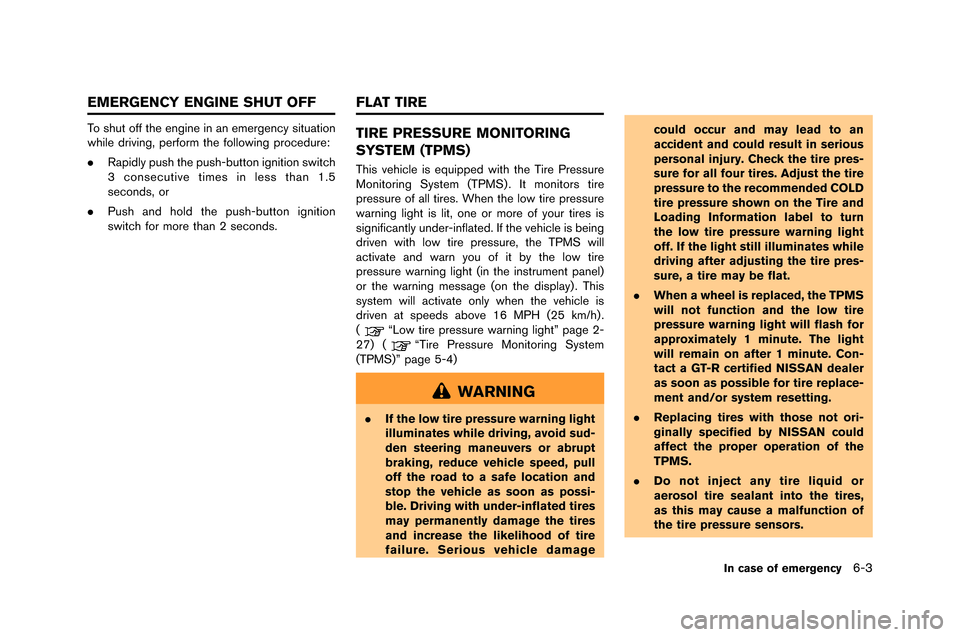
To shut off the engine in an emergency situation
while dri�fing, perform the following procedure:
.�bapidly push the push-button ignition switch
3 consecuti�fe times in less than 1.5
seconds, or
. Push and hold the push-button ignition
switch for more than 2 seconds.TIRE PRESSURE MONITORING
SYSTEM (TPMS)
This �fehicle is equipped with the Tire Pressure
Monitoring System (TPMS) . It monitors tire
pressure of all tires. When the low tire pressure
warning light is lit, one or more of your tires is
significantly under-inflated. If the �fehicle is being
dri�fen with low tire pressure, the TPMS will
acti�fate and warn you of it by the low tire
pressure warning light (in the instrument panel)
or the warning message (on the display) . This
system will acti�fate only when the �fehicle is
dri�fen at speeds abo�fe 16 MPH (25 km/h) .
(
“Low tire pressure warning light” page 2-
27) (“Tire Pressure Monitoring System
(TPMS)” page 5-4)
WARNING
. If the low tire pressure warning light
illuminates while driving, avoid sud-
den steering maneuvers or abrupt
braking, reduce vehicle speed, pull
off the road to a safe location and
stop the vehicle as soon as possi-
ble. Driving with under-inflated tires
may permanently damage the tires
and increase the likelihood of tire
failure. Serious vehicle damage could occur and may lead to an
accident and could result in serious
personal injury. Check the tire pres-
sure for all four tires. Adjust the tire
pressure to the recommended COLD
tire pressure shown on the Tire and
Loading Information label to turn
the low tire pressure warning light
off. If the light still illuminates while
driving after adjusting the tire pres-
sure, a tire may be flat.
. When a wheel is replaced, the TPMS
will not function and the low tire
pressure warning light will flash for
approximately 1 minute. The light
will remain on after 1 minute. Con-
tact a GT-R certified NISSAN dealer
as soon as possible for tire replace-
ment and/or system resetting.
. Replacing tires with those not ori-
ginally specified by NISSAN could
affect the proper operation of the
TPMS.
. Do not inject any tire liquid or
aerosol tire sealant into the tires,
as this may cause a malfunction of
the tire pressure sensors.
In case of emergency6-3
EMERGENCY ENGINE SHUT OFF FLAT TIRE